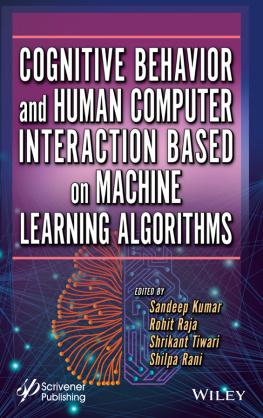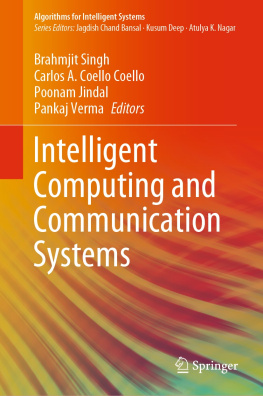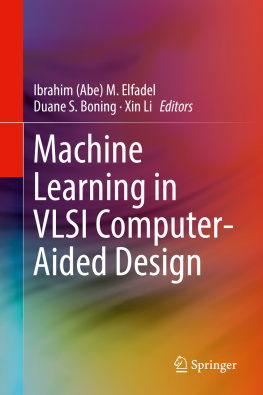
Scrivener Publishing
100 Cummings Center, Suite 541J
Beverly, MA 01915-6106
Publishers at Scrivener
Martin Scrivener ()
Phillip Carmical ()
Cognitive Behavior and Human Computer Interaction Based on Machine Learning Algorithm
Edited by
Sandeep Kumar
Rohit Raja
Shrikant Tiwari
Shilpa Rani

This edition first published 2022 by John Wiley & Sons, Inc., 111 River Street, Hoboken, NJ 07030, USA and Scrivener Publishing LLC, 100 Cummings Center, Suite 541J, Beverly, MA 01915, USA
2022 Scrivener Publishing LLC
For more information about Scrivener publications please visit www.scrivenerpublishing.com.
All rights reserved. No part of this publication may be reproduced, stored in a retrieval system, or transmitted, in any form or by any means, electronic, mechanical, photocopying, recording, or otherwise, except as permitted by law. Advice on how to obtain permission to reuse material from this title is available at http://www.wiley.com/go/permissions.
Wiley Global Headquarters
111 River Street, Hoboken, NJ 07030, USA
For details of our global editorial offices, customer services, and more information about Wiley products visit us at www.wiley.com.
Limit of Liability/Disclaimer of Warranty
While the publisher and authors have used their best efforts in preparing this work, they make no representations or warranties with respect to the accuracy or completeness of the contents of this work and specifically disclaim all warranties, including without limitation any implied warranties of merchant-ability or fitness for a particular purpose. No warranty may be created or extended by sales representatives, written sales materials, or promotional statements for this work. The fact that an organization, website, or product is referred to in this work as a citation and/or potential source of further information does not mean that the publisher and authors endorse the information or services the organization, website, or product may provide or recommendations it may make. This work is sold with the understanding that the publisher is not engaged in rendering professional services. The advice and strategies contained herein may not be suitable for your situation. You should consult with a specialist where appropriate. Neither the publisher nor authors shall be liable for any loss of profit or any other commercial damages, including but not limited to special, incidental, consequential, or other damages. Further, readers should be aware that websites listed in this work may have changed or disappeared between when this work was written and when it is read.
Library of Congress Cataloging-in-Publication Data
ISBN 978-1-119-79160-7
Cover image: Pixabay.Com
Cover design by Russell Richardson
Set in size of 11pt and Minion Pro by Manila Typesetting Company, Makati, Philippines
Printed in the USA
10 9 8 7 6 5 4 3 2 1
Preface
Human-computer interaction (HCI) is the academic discipline, which most of us think of as UI design, that focuses on how human beings and computers interact at ever-increasing levels of both complexity and simplicity. Because of the importance of the subject, this book aims to provide more relevant information that will be useful to students, academics, and researchers in the industry who wish to know more about its realtime application. In addition to providing content on theory, cognition, design, evaluation, and user diversity, this book also explains the underlying causes of the cognitive, social and organizational problems typically devoted to descriptions of rehabilitation methods for specific cognitive processes. Also described are the new modeling algorithms accessible to cognitive scientists from a variety of different areas. Advances in HCI involve interdisciplinary research, the results of which are published in theoretical and applied articles covering a broad spectrum of interactive systems. Therefore, this book is inherently interdisciplinary and publishes original research in computing, engineering, artificial intelligence, psychology, linguistics, and social and system organization as applied to the design, implementation, application, analysis, and evaluation of interactive systems. Since machine learning research has already been carried out for a decade at the international level in various applications, the new learning approach is mainly used in machine learning-based cognitive applications. Since this will direct the future research of scientists and researchers working in neuroscience, neuroimaging, machine learning-based brain mapping and modeling, etc., this book highlights the framework of a novel robust method for advanced cross-industry HCI technologies. These implementation strategies and future research directions will meet the design and application requirements of several modern and real-time applications for a long time to come. Therefore, this book will be a better choice than most available books that were published a long time ago, and hence seldom elaborate on the current advancements necessary for cognitive behavior and HCI algorithms. Included in the book are:
- A review of the state-of-the-art in cognitive behavior and HCI processing models, methods, techniques, etc.
- A review and description of the learning methods in HCI.
- The new techniques and applications in cognitive behavior along with their practical implementation.
- The existing and emerging image challenges and opportunities in the cognitive behavior and HCI field.
- How to promote mutual understanding and networking among researchers in different disciplines.
- The facilitation of future research development and collaborations.
- Real-time applications.
To conclude, we would like to express our appreciation to all of the contributing authors who helped us tremendously with their contributions, time, critical thoughts, and suggestions to put together this peer-reviewed edited volume. The editors are also thankful to Scrivener Publishing and its team members for the opportunity to publish this volume. Lastly, we thank our family members for their love, support, encouragement, and patience during the entire period of this work.
Sandeep Kumar
Rohit Raja
Shrikant Tiwari
Shilpa Rani
October 2021
Cognitive Behavior: Different Human-Computer Interaction Types
S. Venkata Achyuth Rao
CSE, SIET, Hyderabad, Telangana, India
Computer Science and Engineering Department, Koneru Lakshmaiah Education Foundation, Vaddeswaram, Andra Pradesh, India
Operations & Supply Chain, MBA (Healthcare & Hospital Management), School of Management Studies, University of Hyderabad, Telangana, India
Abstract
Cognitive behavior plays a significant and strategic role in human-computer interaction devices that are deployed nowadays, with artificial intelligence, deep learning, and machine learning computing techniques. User experience is the crucial factor of any successful interacting device between machine and human. The idea of providing a HCUIMS is to create interfaces in terms of the bottom level of any organization as Decision Processing User Interacting Device System (DPUIDS), next at middle level management, Decision Support User Interacting Device Systems (DSUIDS), lastly at executive level, Management Information User Interacting Device System (MIUIDS), where decisions can take at uncertainty at various catastrophic situations. Here are specific gaps demonstrated in the various users processes in communicating with computers and that cognitive modeling is useful in the inception phase to evolve the design and provide training.
Next page





![Lajoie Susanne P(Editor) - Computers as cognitive tools. [1]](/uploads/posts/book/250179/thumbs/lajoie-susanne-p-editor-computers-as-cognitive.jpg)



